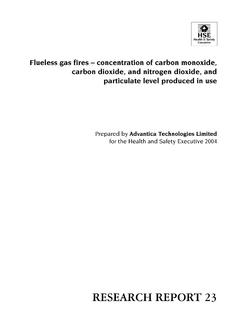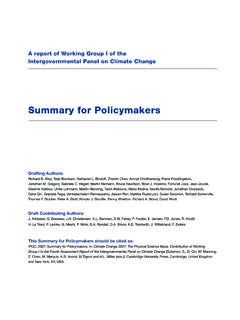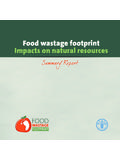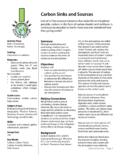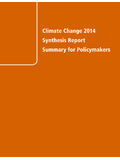Transcription of Glass Recycling - Life Cycle Carbon Dioxide Emissions
1 British Glass , 9 Churchill Way, SHEFFIELD, S35 2 PYT: 0114 290 1850 F: 0114 290 1851E: Recycling - life Cycle Carbon Dioxide EmissionsA life Cycle Analysis ReportPrepared for British Glassby Enviros Consulting LtdNovember 2003 QUALITY CONTROL SHEET Publication title Glass Recycling life Cycle Carbon Dioxide Emissions CAN BR110 004 Volume number Volume 1 of 1 Version Final Report Date February 2004 File Reference Final Report Prepared under the management of: Joe Flanagan Project Manager Directed, reviewed and approved by: Mike Davies Project Director Client Address: British Glass Manufacturers Confederation Public Affairs Committee 9 Churchill Way Sheffield S35 2PY Dr Nick Kirk Tel +44 (0) 114 290 1801 Fax +44 (0) 114 268 1073 Email Enviros Contact Details.
2 Enviros Consulting Ltd Telegraphic House Waterfront Quay Salford Quays Manchester M50 3XW Joe Flanagan, Consulting Group Manager Tel 0161 874 3655 Fax 0161 848 8181 Email Web CONTENTS PAGE EXECUTIVE summary 1 1. INTRODUCTION 4 Background to the Project 4 UK Waste Arisngs 4 The UK Climate Change Programme 5 2. THE life Cycle ANALYSIS APPROACH 7 3. CURRENT UK SITUATION 9 Transport Related Emissions 10 Transport Assumptions 12 4.
3 BENEFITS OF Glass Recycling 13 Glass Container Manufacture 13 Insulation Glass Fibre Manufacture 17 Aggregate Applications 18 Filtration Media 20 Brick Manufacturing 21 Shot Blast Abrasives 23 summary 24 5. IMPLICATIONS FOR FUTURE Glass Recycling POLICY 26 APPENDICES 1. ESTIMATION OF TRANSPORT DISTANCES FOR RECYCLED Glass 2. summary OF DATA ANALYSIS FOR UK Glass FURNACES 3. CALCULATION OF Carbon Dioxide Emissions FROM SODA ASH PRODUCTION 4. GLOSSARY AND DEFINITIONS Glass Recycling life Cycle Carbon Dioxide Emissions EXECUTIVE summary Waste management and climate change are two major environmental issues.
4 Government and EU policy is increasingly driving waste reduction and improved Recycling . Both the landfill directive and the packaging regulations are designed to achieve these goals. Glass is a major packaging material and it is estimated that around million tonnes of waste Glass bottles and jars enter the waste stream every year. In 2002, 747,415 tonnes of this waste Glass was recycled, representing a Recycling rate of 34% which is quite poor compared to many other European countries that achieve Recycling rates of over 80%.
5 Future Government targets and legislation are likely to increase the pressure to recycle and it is likely that a UK Glass packaging Recycling target of 60% (equivalent to million tonnes) will be set for 2006. The traditional route for recycled container Glass has been to use it as a feedstock in the manufacture of new Glass containers. However, recent growth in Recycling has been disappointing and the past 3 years has seen significant growth in alternative uses for recycled Glass .
6 These applications are mainly using Glass as an aggregate where it substitutes virgin quarried materials. In 2002, it was estimated that 150,000 tonnes of Glass went to aggregate applications and much of this growth was attributed to high PRN values and the investment in commercial mixed Glass collection provided by Valpak. There are a number of other possible applications for recycled Glass including use as a filtration media and as a fluxing agent in brick manufacture.
7 The Waste Resources Action Programme (WRAP) has provided support for a number of R&D projects relating to these applications. The main theme of this study is the link between Glass Recycling and climate change. As a result of increasing levels of greenhouse gases (GHGs) in the atmosphere the climate is generally warming up. The likely consequences of this warming are disrupted weather patterns and rising sea levels; both effects will have severe impacts on mankind.
8 Carbon Dioxide (CO2) is one of the principal GHGs accounting for 80% of UK GHG Emissions . Under the Kyoto Protocol the UK is committed to reducing GHG Emissions by by 2010 and the Government has recently stated a longer term goal of reducing these Emissions by 60% by 2060. A methodology has been developed for calculating the life Cycle CO2 Emissions for various Glass Recycling options which are: 1. Glass is manufactured from virgin raw materials and waste containers are disposed to landfill at the end of their life a base case of no Glass Recycling 2.
9 Glass is recycled and used as a feedstock for the manufacture of new Glass containers. 3. Glass is recycled and used as a feedstock for the manufacture of Glass fibre insulation. 4. Glass is recycled and used as an aggregate substituting quarried materials. 5. Glass is recycled and used as a filtration media substituting quarried sand or gravel. 6. Glass is recycled and used as a shot blast abrasive. 7. Glass is recycled and used as an additive in clay brick manufacturing. BRITISH Glass MANUFACTURERS CONFEDERATION PUBLIC AFFAIRS COMMITTEE 1 Glass Recycling life Cycle Carbon Dioxide Emissions For each application the life Cycle CO2 Emissions have been calculated when virgin raw materials are used and when recycled Glass substitutes these materials.
10 All sources of CO2 have been considered including quarrying, raw material preparation transport, product manufacture, recycled Glass collection and recycled Glass processing. Figure 1 CO2 Emission Savings for Recycled Glass Applications -50050100150200250300350CO2 Emission Savings kg/tonne of recycled glasskg CO2/tonne3142902756619-43-2 Glass containersGlass containers (foreign Glass FibreBricksShot BlastFiltrationAggregatesCO2 Savings Figure 1 clearly shows that the greatest CO2 savings result when recycled Glass is used as a feed stock for the manufacture of new Glass since.)

